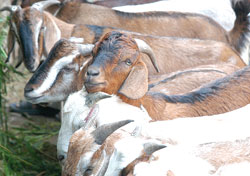|
|
The back of the truck opens, its dazed occupants slowly emerge in single file down a straight wooden plank. Their eyes are glazed and legs jittery. Some seem glad to just stretch their legs.
The journey from Birganj has been eight hours of misery for the passengers. It's standing room only, wedged with 50 others in the back of a Tata truck.
Through the constant roaring of the truck, bouncing through potholes drivers are too lazy to avoid, and the incessant lurching from the stop-start traffic. There is no toilet break, no food stop.
At one depot at Khumaltar alone, 25 of these trucks arrive every month. There are dozens of similar drop off points in the Valley. The buffalos are downloaded at river banks or abandoned factory premises, allowed to graze and fatten a bit and then slaughtered. When the Valley's population was still low, demand was met by local buffaloes. But more and more of the buffaloes now are imported from India, where they are not eaten.
"If they're big buffaloes, we can fit in around 30," says Shekh Atikur, a truck driver. "For the smaller ones, up to 70 can be squeezed in." Atikur brings in about 10 truckloads each month, but exonerates himself from any responsibility for the way they are treated.
"It is the people high up who load them up like that," he says. "We drivers have nothing to do with it. I've only had a maximum of three die on a single trip."
Gafara Ansari, a dealer who has been transporting buffaloes to Kathmandu from Birganj for the past 25 years, appears less harsh-hearted. "We let them off to graze if there's a traffic jam," he says. "Even animals need their fresh air."
Ansari claims a profit of just Rs 200 per buffalo, with prices ranging from Rs 3,000-25,000 according to size. He complains that there is no place to unload them in the city. "Everyone wants to eat them but no one wants to see them," he says. In the past, he has used deserted factories or sites beside the city's rivers. Now he is offloading them in Khumaltar.
There is no limit to age or size, with even young calves and females eligible for slaughter. The young ones are the simplest to kill. The smaller they are, the easier it is for the butcher to decapitate them cleanly. The bigger ones are bludgeoned to death. The butcher repeatedly smashes their forehead with a heavy hammer until they die. The calves are put on a spit and roasted, skin and all, over a fire.
The older ones are hacked into more manageable pieces before the cuts are sold. Buff is the most popular meat for momos, and apparently the cooks aren't very particular about what they buy.
"As long as the meat is minced, no one cares what it includes," says Dipen Khadka, my local butcher. "I've ground almost every part of the buffalo, excluding the hooves, horns and the bigger bones. Every other part has gone into one of those momos."
A large, well-fleshed buffalo ambled up, it had a red splotch on its forehead, a mark of ownership and a death sentence. In a few hours this animal would be meat.
The carnivore carnival
 The proof that Dasain is around the corner is the sight of four or five goats riding the top luggage carrier of a microbus. The carnivore carnival is here and livestock don't stand a chance. Goats, buffaloes, chicken, sheep, and ducks. None will be spared this season as Nepalis binge for ten days on meat.
The proof that Dasain is around the corner is the sight of four or five goats riding the top luggage carrier of a microbus. The carnivore carnival is here and livestock don't stand a chance. Goats, buffaloes, chicken, sheep, and ducks. None will be spared this season as Nepalis binge for ten days on meat.
The khasi, like the buffaloes, arrive from the tarai by truckloads. Mountain goats (chyangra) from our other friendly neighbour in the north. The Kalanki Khasi Market is at full capacity. Due to the instability in the tarai there is a severe shortage of goats which has pushed prices up.
The shortage of goats is being compensated for by a chicken glut. The birds are transported to market in pickups or even five fowls dangling from either side of a motorcycle. A single truck can carry more than a hundred, in rows of twenty each, one on top of the other, trapped in wire-mesh cages. The ones on the bottom row are the lowest in the pecking order and they are covered in droppings.
Pretty soon, it will be off with their heads at temples, sidewalks, backyards and picnic spots throughout the country. The debate about animal sacrifice and open slaughter will probably never be resolved. There are those who argue for humane slaughter by knocking the animal unconscious before killing it. But it is difficult to say who is civilised and who is not based on the method of slaughter.
Perhaps the only civilised people are vegetarians.



